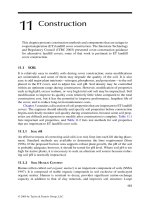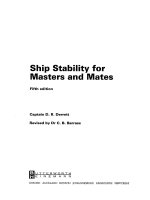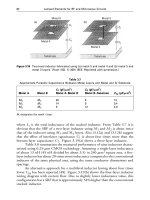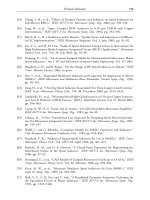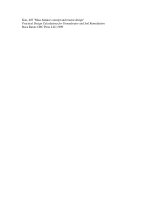Ship Stability for Masters and Mates 5 Episode 11 ppsx
Bạn đang xem bản rút gọn của tài liệu. Xem và tải ngay bản đầy đủ của tài liệu tại đây (830.38 KB, 35 trang )
applied to ®nd the longitudinal shearing forces and bending moments in
¯oating vessels. Suf®cient accuracy of prediction can be obtained.
However, beam theory such as this cannot be used for supertankers and
ULCCs. For these very large vessels it is better to use what is known as the
®nite element theory. This is beyond the remit of this book.
Bending of beams 339
EXERCISE 40
1 A beam AB of length 10 m is supported at each end and carries a load which
increases uniformly from zero at A to 0.75 tonnes per metre run at B. Find
the position and magnitude of the maximum bending moment.
2 A beam 15 m long is supported at its ends and carries two point loads. One
of 5 tonnes mass is situated 6 m from one end and the other of 7 tonnes mass
is 4 m from the other end. If the mass of the beam is neglected, sketch the
curves of shearing force and bending moments. Also ®nd (a), The maximum
bending moment and where it occurs, and (b), The bending moment and
shearing force at
1
3
of the length of the beam from each end.
Chapter 41
Bending of ships
Longitudinal stresses in still water
First consider the case of a homogeneous log of rectangular section ¯oating
freely at rest in still water as shown in Figure 41.1.
The total weight of the log is balanced by the total force of buoyancy
and the weight (W) of any section of the log is balanced by the force of
buoyancy (B) provided by that section. There is therefore no bending
moment longitudinally which would cause stresses to be set up in the log.
Now consider the case of a ship ¯oating at rest in still water, on an even
keel, at the light draft as shown in Figure 41.2
Although the total weight of the ship is balanced by the total force of
buoyancy, neither is uniformly distributed throughout the ship's length.
Imagine the ship to be cut as shown by a number of transverse sections.
Imagine, too, that each section is watertight and is free to move in a vertical
direction until it displaces its own weight of water. The weight of each of
the end sections (1 and 5) exceeds the buoyancy which they provide and
these sections will therefore sink deeper into the water until equilibrium is
reached at which time each will be displacing its own weight of water. If
Fig. 41.1
sections 2 and 4 represent the hold sections, these are empty and they
therefore provide an excess of buoy ancy over weight and will rise to
displace their own weight of water. If section 3 represents the engine room
then, although a considerable amount of buoyancy is provided by the
section, the weight of the engines and other apparatus in the engine room,
may exceed the buoyancy and this section will sink deeper into the water.
The nett result would be as shown in Figure 41.3 where each of the sections
is displacing its own weight of water.
Although the sections in the ship are not free to move in this way,
bending moments, and consequently longitudinal stresses, are created by
the variation in the longitudinal distribution of weight and buoyancy and
these must be allowed for in the construction of the ship.
Longitudinal stresses in waves
When a ship encounters waves at sea the stresses created differ greatly
from those created in still water. The maximum stresses are considered to
exist when the wave length is equal to the ship's length and either a wave
crest or trough is situated amidships.
Consider ®rst the effect when the ship is supported by a wave having its
crest amidships and its troughs at the bow and the stern, as shown in Figure
41.4.
Bending of ships 341
Fig. 41.2
Fig. 41.3
Fig. 41.4
In this case, although once more the total weight of the ship is balanced
by the total buoyancy, there is an excess of buoyancy over the weight
amidships and an excess of weight over buoyancy at the bow and the stern.
This situation creates a tendency for the ends of the ship to move
downwards and the section amidships to move upwards as shown in
Figure 41.5.
Under these conditions the ship is said to be subjected to a `Hogging'
stress.
A similar stress can be produced in a beam by simply supporting it at its
mid-point and loading each end as shown in Figure 41.6.
Consider the effect after the wave crest has moved onwards and the ship
is now supported by wave crests at the bow and the stern and a trough
amidships as shown in Figure 41.7.
There is now an excess of buoyancy over weight at the ends and an
excess of weight over buoyancy amidships. The situation creates a
tendency for the bow and the stern to move upwards and the section
amidships to move downwards as shown in Figure 41.8.
Under these conditions a ship is said to be subjected to a sagging stress.
A stress similar to this can be produced in a beam when it is simply
supported at its ends and is loaded at the mid-length as shown in Figure
41.9.
342 Ship Stability for Masters and Mates
Fig. 41.5
Fig. 41.6
Weight, buoyancy and load diagrams
It has already been shown that the total weight of a ship is balanced by the
total buoyancy and that neither the weight nor the buoyancy is evenly
distributed throughout the length of the ship.
In still water, the uneven loading which occurs throughout the length of
a ship varies considerably with different conditions of loading and leads to
longitudinal bending moments which may reach very high values. Care is
therefore necessary when loading or ballasting a ship to keep these values
within acceptable limits.
In waves, additional bending moments are created, these being brought
about by the uneven distribution of buoyancy. The maximum bending
moment due to this cause is considered to be created when the ship is
Bending of ships 343
Fig. 41.7
Fig. 41.8
Fig. 41.9
moving head-on to waves whose length is the same as that of the ship, and
when there is either a wave crest or trough situated amidships.
To calculate the bending moments and consequent shearing stresses
created in a ship subjected to longitudinal bending it is ®rst necessary to
construct diagrams showing the longitudinal distribution of weight and
buoyancy.
The weight diagram
A weight diagram shows the longitudinal distribution of weight. It can be
constructed by ®rst drawing a base line to represent the length of the ship,
and then dividing the base line into a number of sections by equally spaced
ordinates as shown in Figure 41.10. The weight of the ship between each
pair of ordinates is then calculated and plotted on the diagram. In the case
considered it is assumed that the weight is evenly distributed between
successive ordinates but is of varying magnitude.
Let
CSA Cross Sectional Area
344 Ship Stability for Masters and Mates
Fig. 41.10. Shows the ship divided into 10 elemental strips along her length
LOA. In practice the Naval Architect may split the ship into 40 elemental strips in
order to obtain greater accuracy of prediction for the weight distribution.
Bonjean Curves
Bonjean Curves are drawn to give the immersed area of transverse sections
to any draft and may be used to determine the longitudinal distribution of
buoyancy. For example, Figure 41.11(a) shows a transverse section of a ship
and Figure 41.11(b) shows the Bonjean Curve for the same section. The
immersed area to the waterline WL is represented on the Bonjean Curve by
ordinate AB, and the immersed area to waterline W
1
L
1
is represented by
ordinate CD.
In Figure 41.12 the Bonjean Curves are shown for each section
throughout the length of the ship. If a wave formation is superimposed
on the Bonjean Curves and adjusted until the total buoyancy is equal to the
total weight of the ship, the immersed transverse area at each section can
then be found by inspection and the buoyancy in tonnes per metre run is
equal to the immersed area multiplied by 1.025.
Bending of ships 345
Fig. 41.11
Fig. 41.12
Chapter 42
Strength curves
for ships
Strength curves consist of ®ve curves that are closely inter-related. The
curves are:
1 Weight curve ± tonnes/m run or kg/m run.
2 Buoyancy curve ± either for hogging or sagging condition ± tonnes/m
or kg/m run.
3 Load curve ± tonnes/m run or kg/m run.
4 Shear force curve ± tonnes or kg.
5 Bending moment curve ± tonnes m or kg m.
Some forms use units of MN/m run, MN and MN. m.
Buoyancy curves
A buoyancy curve shows the longitudinal distribution of buoyancy and can
be constructed for any wave formation using the Bonjean Curves in the
manner previously described in Chapter 41. In Figure 42.1 the buoyancy
Fig. 42.1
curves for a ship are shown for the still water condition and for the
conditions of maximum hogging and sagging. It should be noted that the
total area under each curve is the same, i.e. the total buoyancy is the same.
Units usually tonnes/m run along the length of the ship.
Load curves
A load curve shows the difference between the weight ordinate and
buoyancy ordinate of each section throughout the length of the ship.
The curve is drawn as a series of rectangles, the heights of which are
obtained by drawing the buoyancy curve (as shown in Figure 42.1) parallel
to the weight curve (as shown in Figure 41.10) at the mid-ordinate of a
section and measuring the difference between the two curves. Thus the load
is considered to be constant over the length of each section. An excess of
weight over buoyancy is considered to produce a positive load whilst an
excess of buoyancy over weight is considered to produce a negative load.
Units are tonnes/m run longitudinally.
Shear forces and bending moments of ships
The shear force and bending moment at any section in a ship may be
determined from load curve. It has already been shown that the shearing
force at any section in a girder is the algebraic sum of the loads acting on
either side of the section and that the bending moment acting at any
section of the girder is the algebraic sum of the moments acting on either
Strength curves for ships 347
Fig. 42.2. Showing three ship strength curves for a ship in still water conditions
side of the section. It has also been shown that the shearing force at any
section is equal to the area under the load curve from one end to the section
concerned and that the bending moment at that section is equal to the area
under the shearing force curve measured from the same end to that section.
Thus, for the mathematically minded, the shear force curve is the ®rst-
order integral curve of the load curve and the bending moment curve is the
®rst-order integral curve of the shearing force curve. Therefore, the bending
moment curve is the second-order integral curve of the load curve.
Figure 42.2 shows typical curves of load, shearing force and bending
moments for a ship in still water.
After the still water curves have been drawn for a ship, the changes in the
distribution of the buoyancy to allow for the conditions of hogging and
sagging can be determined and so the resultant shearing force and bending
moment curves may be found for the ship in waves.
Example
A box-shaped barge of uniform construction is 32 m long and displaces 352
tonnes when empty, is divided by transverse bulkheads into four equal
compartments. Cargo is loaded into each compartment and level stowed as
follows:
No. 1 hold N 192 tonnes No. 2 hold N 224 tonnes
No. 3 hold N 272 tonnes No. 4 hold N 176 tonnes
Construct load and shearing force diagrams, before calculating the bending
moments at the bulkheads and at the position of maximum value; hence draw
the bending moment diagram.
Mass of barge per metre run
Mass of barge
Length of barge
352
32
11 tonnes per metre run
mass of barge when empty 352 tonnes
Cargo 192 224 272 176
864 tonnes
Total mass of barge and cargo 352 864
1216 tonnes
Buoyancy per metre run
Total buoyancy
Length of barge
1216
32
38 tonnes per metre run
348 Ship Stability for Masters and Mates
From Figure 42.3.
Bending moments along the barge's length
BM
8
8 Â 40
2
160 t m
160 tonnes m
BM
0
0tm
BM
4
20 Â 4
2
40 t m
Strength curves for ships 349
Fig. 42.3
BM
8
8 Â 40
2
160 t m
BM
13
5
7
13
5
7
 40
2
274X3tm
BM
16
13
5
7
 40
2
À
2
2
7
 16
2
256 t m
BM
20
256 À
16 20
2
E4 184 t m
BM
24
184 À
20 24
2
E4 96 t m
BM
28
96 À
24 12
2
E4 24 t m
BM
32
24 À
12 Â 4
2
0tm
Murray's Method
Murray's Method is used to ®nd the total longitudinal bending moment
amidships on a ship in waves and is based on the division of th e total
bending moment into two parts:
(a) the Still Water Bending Moment, and
(b) the wave bending moment.
The Still Water Bending Moment is the longitudinal bending moment
amidships when the ship is ¯oating in still water.
When using Murray's Method the wave bending moment amidships is
that produced by the waves when the ship is supported on what is called a
`Standard Wave'. A Standard Wave is one whose length is equal to the
length of the ship (L), and whose height is equal to 0.607
L
p
, where L is
measured in metres. See Figure 42.4.
The Wave Bending Moment is then found using the formula:
WBM bEBEL
2X5
 10
À3
tonnes metres
where B is the beam of the ship in metres and b is a constant based on the
ship's block coef®cient (C
b
) and on whether the ship is hogging or sagging.
The value of b can be obtained from the table on page 351.
The Still Water Bending Moment (SWBM)
Let
W
F
represent the moment of the weight forward of amidships,
B
F
represent the moment of buoyancy forward of amidships,
350 Ship Stability for Masters and Mates
Let
W
A
represent the moment of the weight aft of amidships,
B
A
represent the moment of the buoyancy aft of amidships, and
W represent the ship's displacement,
then:
Still Water Bending Moment (SWBMW
F
À B
F
W
A
À B
A
This equation can be accurately evaluated by resolving in detail the many
constituent parts, but Murray's Method may be used to give an
approximate solution with suf®cient accuracy for practical purposes.
Strength curves for ships 351
Fig. 42.4
Murray's coef®cient `b' values
Values of b
C
b
Hogging Sagging
0.80 10.555 11.821
0.78 10.238 11.505
0.76 9.943 11.188
0.74 9.647 10.850
0.72 9.329 10.513
0.70 9.014 10.175
0.68 8.716 9.858
0.66 8.402 9.541
0.64 8.106 9.204
0.62 7.790 8.887
0.60 7.494 8.571
The following approximations are then used:
Mean Weight Moment M
W
W
F
W
A
2
This moment is calculated using the full particulars of the ship in its loaded
condition.
Mean Buoyancy Moment M
B
W
2
 Mean LCB of fore and aft bodies
An analysis of a large number of ships has shown that the Mean LCB of the
fore and aft bodies for a trim not exceeding 0.01 L can be found using the
formula:
Mean LCB L ÂC
where L is the length of the ship in metres, and the value of C can be found
from the following table in terms of the block coef®cient (C
b
) for the ship at
a draft of 0.06 L.
The Still Water Bending Moment Amidships (SWBM) is then given by
the formula:
SWBM Mean Weight Moment M
W
À Mean Buoyancy Moment M
B
or
SWBM
W
F
W
A
2
À
W
2
ELEC
where the value of C is found from the table above.
If the Mean Weight Moment is greater than the Mean Buoyancy
Moment then the ship will be hogged, but if the Mean Buoyancy
Moment exceeds the Mean Weight Moment then the ship will sag. So
(i) If M
W
b M
B
ÁÁÁÁÁÁÁÁship hogs.
(ii) If M
B
b M
W
ÁÁÁÁÁÁÁÁship sags.
}
M
W
M
B
The Wave Bending Moment (WBM)
The actual wave bending moment depends upon the height and the length
of the wave and the beam of the ship. If a ship is supported on a Standard
352 Ship Stability for Masters and Mates
Murray's coef®cient `C' values
Draft C
0.06 L 0.179C
b
0.063
0.05 L 0.189C
b
0.052
0.04 L 0.199C
b
0.041
0.03 L 0.209C
b
0.030
E
E
Wave, as de®ned above, then the Wave Bending Moment (WBM) can be
calculated using the formula:
WBM bEBEL
2X5
 10
À3
tonnes metres
where B is the beam of the ship and where the value of b is found from the
table on page 351.
Example
The length LBP of a ship is 200 m, the beam is 30 m and the block coef®cient is
0.750. The hull weight is 5000 tonnes having LCG 25.5 m from amidships. The
mean LCB of the fore and after bodies is 25 m from amidships. Values of the
constant b are: hogging 9.795 and sagging 11.02.
Given the following data and using Murray's Method, calculate the longi-
tudinal bending moments amidships for the ship on a standard wave with: (a)
the crest amidships, and (b) the trough amidships. Use Figure 42.5 to obtain
solution.
Strength curves for ships 353
TBM (Total Bending Moment)
M
W
M
B
SWBM
bEBEL
2X5
 10
À3
WBM
E
E
Fig. 42.5. Line diagram for solution using Murray's method.
To ®nd the Still Water Bending Moment (SWBM)
Mean Weight Moment M
W
W
F
W
A
2
458 450
2
M
W
229 225 t m
Mean Buoyancy Moment M
B
W
2
ELCB
16 950
2
E25
211 875 t m
Still Water Bending Moment SWBMM
W
À M
B
229 225 À211 875
SWBM 17 330 t m Hogging because M
W
b M
B
(see page 352)
354 Ship Stability for Masters and Mates
Item Weight LCG from amidships Moment
No. 1 hold 1800 55.0 m forward 99 000
No. 2 hold 3200 25.5 m forward 81 600
No. 3 hold 1200 5.5 m forward 6 600
No. 4 hold 2200 24.0 m aft 52 800
No. 5 hold 1500 50.0 m aft 75 000
Machinery 1500 7.5 m aft 11 250
Fuel oil 400 8.0 m aft 3200
Fresh water 150 10.0 m forward 1500
Hull 5000 25.5 m 127 500
16 950 458 450
Data
Item Weight LCG from amidships
No. 1 hold 1800 t 55.0 m aft
No. 2 hold 3200 t 25.5 m forward
No. 3 hold 1200 t 5.5 m forward
No. 4 hold 2200 t 24.0 m aft
No. 5 hold 1500 t 50.0 m aft
Machinery 1500 t 7.5 m aft
Fuel oil 400 t 8.0 m aft
Fresh water 150 t 10.0 m forward
Wave Bending Moment (WBM)
Wave Bending Moment WBMbEBEL
2X5
 10
À3
tm
WBM Hogging 9X795 Â 30 Â 200
2X5
 10
À3
tm
166 228 t m
WBM Sagging 11X02 Â 30 Â 200
2X5
 10
À3
tm
187 017 t m
Total Bending Moment (TBM)
TBM Hogging WBM hogging SWBM hogging
166 228 17 350
183 578 t m
TBM Sagging WBM Sagging À SWBM hogging
187 017 À17 350
169 667 t m
Answer (a) with crest amidships, the Total Bending Moment, TBM is
183 578 tonnes metres.
Answer (b) with trough amidships, the Total Bending Moment, TBM is
169 667 tonnes metres.
The greatest danger for a ship to break her back is when the wave crest is
at amidships, or when the wave trough is at amidships with the crests at the
stem and at the bow.
In the previous example the greatest BM occurs with the crest amidships.
Consequently, this ship would fracture across the Upper Deck if the tensile
stress due to hogging condition became too high.
Strength curves for ships 355
Chapter 43
Bending and shear
stresses
The shear forces and bending moments which act upon a ship's structure
cause shear and bending stresses to be generated in the structure. We have
seen earlier that the shearing forces and bending moments experienced by a
ship are similar to those occurring in a simply supported beam. We shall
therefore consider the shear and bending stresses created when an ordinary
beam of rectangular section is simply supported.
Bending stresses
The beam in Figure 43.1(a) is rectangular in cross-section, is simply
supported at each end and has a weight W suspended from its mid-point.
This distribution will tend to cause the beam to bend and sag as shown in
Figure 43.1(b).
Consider ®rst the bending stresses created in the beam. Let ab and cd in
Figure 43.1(a) be two parallel sections whose planes are perpendicular to
the plane AB. Let their distance apart be dx. When the beam bends the
Fig. 43.1(a)
planes of these two sections will remain perpendicular to the plane AB but
will now be inclined at an angle dy to each other. The parts of the beam
above the layer AB are in compression and those below the layer AB are in
tension. Thus the layer AB is neither in compression or tension and this
layer is called the Neutral Axis.
Let the radius of curvature of the neutral axis layer be R.
Consider a layer of thickness dy which is situated at distance y from the
plane of the Neutral Axis.
Original length of layer dx
After bending, this length REdy no stress or strain here
Length of layer after bending R ydy at a distance y below A À B
But
Strain
Elongation
Orig. length
R ydy À RdEy
RdEy
Strain y/R
This equation indicates that strain varies directly as the distance from the
neutral axis. Also, if the modules of elasticity is constant throughout the
beam, then:
E
Stress
Strain
or
Stress E ÂStra in
Bending and shear stresses 357
Fig. 43.1(b)
and
Stress E Â
y
R
So
f E Â
y
R
This equation indicates that stress is also directly proportional to distance
from the neutral axis, stress being zero at the neutral axis and attaining its
maximum value at top and bottom of the beam. The ®bres at the top of the
beam will be at maximum compressive stress whilst those at the bottom
will be at maximum tensile stress. Since the beam does not move laterally,
the sum of the tensile stresses must equal the sum of the compressive
stresses. This is illustrated in Figure 43.2.
Figure 43.3 shows the cross-section of the beam at ab. NA is a section of
the neutral surface at ab and is called the neutral axis at ab. At NA there is
no compressive or tensile stress, so f 0.
In Figure 43.3 bdy is an element of area at distance y from the Neutral
Axis. Let bdy be equal to dA. The force on dA is equal to the product of the
stress and the area. i.e.
Force on dA
Ey
R
 dA.
358 Ship Stability for Masters and Mates
Fig. 43.2. Bending Stress diagram for a Beam in a sagging condition of loading.
The total or resultant force on the section is equal to the sum of the forces
on the section. i.e.
Total or Resultant force on the section S
Ey
R
dA
But the total or resultant force on the section is zero.
;S
Ey
R
dA 0
Since E and R are constant, then
S ydA 0
But SydA is the ®rst moment of the area about the neutral axis and if this is
to be equal to zero then the neutral axis must pass through the centre of
gravity of the section. In the case being considered, the neutral axis is at
half-depth of the beam.
The sum of the moments of the internal stresses on the section is equal to
M, the external bending moment at the section.
At a distance y from the neutral axis, the moment (m) of the stress acting
on dA is given by the formula:
m
Ey
R
 y ÂdA
Also,
M S
Ey
R
 y ÂdA
S
E
R
y
2
dA
Bending and shear stresses 359
Fig. 43.3
Since E and R are constant, then:
M
E
R
S y
2
dA
But S y
2
dA is the second moment of the area of the section about the
neutral axis. Let S y
2
dA be equal to I.
; M
E
R
 I
Now if f is the stress at a distance of y from the neutral axis, then:
f
Ey
R
or
E
R
f
y
But
M
I
E
R
;
f
y
M
I
and
f
M
I/y
The expression I/y is called the section modulus, designated Z, and attains
its minim um value when y has its maximum value. The section modulus is
the strength criterion for the beam so far as bending is concerned.
Example
A steel beam is 40 cm deep and 5 cm wide. The bending moment at the middle
of its length is 15 tonnes metre. Find the maximum stress on the steel.
I
lb
3
12
5 Â 40
3
12
I
80 000
3
cm
4
f
M
I
 y
y
d
2
40
2
20 cm
So
f
1500 Â 3 Â20
80 000
tonnes per sq cm
f 1X125 tonnes per sq cm
Ans.
Maximum Stress 1X125 tonnes per sq cm or 1125 kg per sq cm
360 Ship Stability for Masters and Mates
Example
A deck beam is in the form of an H-girder as shown in the accompanying
Figure 43.4.
If the bending moment at the middle of its length is 15 tonnes metres, ®nd the
maximum stress in the steel.
I
BH
3
À 2bh
3
12
I
30 Â 30
3
À 2X14X25
3
12
I
810 000 À437 500
12
I
372 500
12
cm
4
f
M
I
Ey
y
H
2
30
2
15 cm
f
1500 Â 12
372 500
 15
f 0X725 tonnes per sq cm
Ans.
Max. Stress 0X725 tonnes per sq cm or 725 kg per sq cm
The above theory can now be used to ®nd the section modulus of the ship.
The external bending moment can be calculated, as can the stress at the
transverse sections under the conditions of maximum bending moment. The
neutral axis passes through the centre of gravity of the section and, because of
this, its position can be found. The moments of inertia of all of the continuous
longitudinal material about this axis can be found. Then the section modulus is
equal to I/y.
Shearing Stresses
It has already been shown that a shearing stress across one plane within a
material produces another shearing stress of equal intensity on a plane at
right angles. (See Complementary Stresses in Chapter 40.)
The mean shearing stress in any section of a structure can be obtained by
Bending and shear stresses 361
Fig. 43.4
dividing the shearing force at that section by the cross-sectional area of the
section. i.e.
Mean shearing stress
F
A
where
F Vertical shearing force and
A Area of cross-section
A more accurate estimati on of shear stress distribution can be obtained
from a consideration of the bending of beams.
Consider the short length of beam dx in Figure 43.5(a) which lies
between the vertical planes ab and cd. Let dy be a layer on this short
length of beam which is situated at distance y from the neutral plane.
From the formula for bending moments deduced earlier, the longitudinal
stress `f' on a small area bEdy of section ab can be found from the formula:
f
M
1
I
1
Ey
where
M
1
the bending moment at this section,
I
1
second moment of the section abut the neutral axis, and
y the distance of the area from the neutral axis.
362 Ship Stability for Masters and Mates
Fig. 43.5
Let
bEdy dA
The force acting on dA fEdA
M
1
I
1
yEdA
Let A
1
be the cross-sectional area at ab, then the total force (P
1
) acting on
the area A
1
is given by:
P
1
M
1
I
1
 S yEdA
M
1
I
1
 y ÂA
1
Let P
2
be the force acting on the same area (A
2
) at section cd.
Then
P
2
M
2
I
2
 y ÂA
2
where
M
2
Bending moment at this section,
and
I
2
Second moment of the section about the neutral axis.
Since dx is small then A
1
A
2
and I
1
I
2
. Therefore let A
area and I second moment of the section about the neutral axis.
Shearing force at A P
1
À P
2
M
1
À M
2
I
 y ÂA
M
1
À M
2
dx
Â
dx Ây  A
I
But
M
1
À M
2
dx
is equal to the vertical shearing force at this section of the
beam.
; P
1
À P
2
F Â
y ÂA Â dx
I
Now let `q' be the shearing stress per unit area at A and let `t' be the
thickness of the beam, then the shearing force is equal to qEtEdx.
; qEtEdx
F Ây  A Âdx
I
Bending and shear stresses 363
![ship stability for masters and mates [electronic resource]](https://media.store123doc.com/images/document/14/y/bj/medium_bjc1401370968.jpg)
